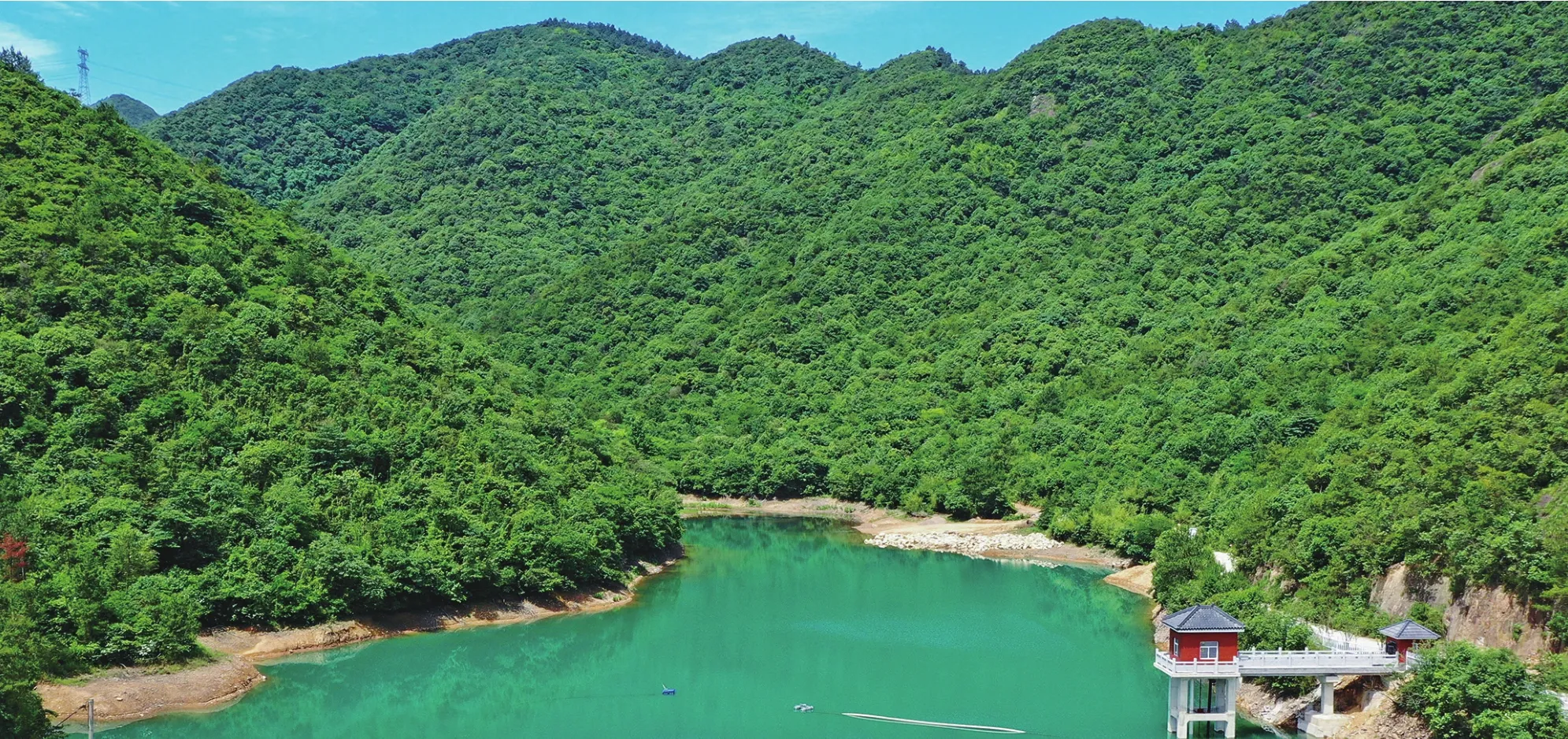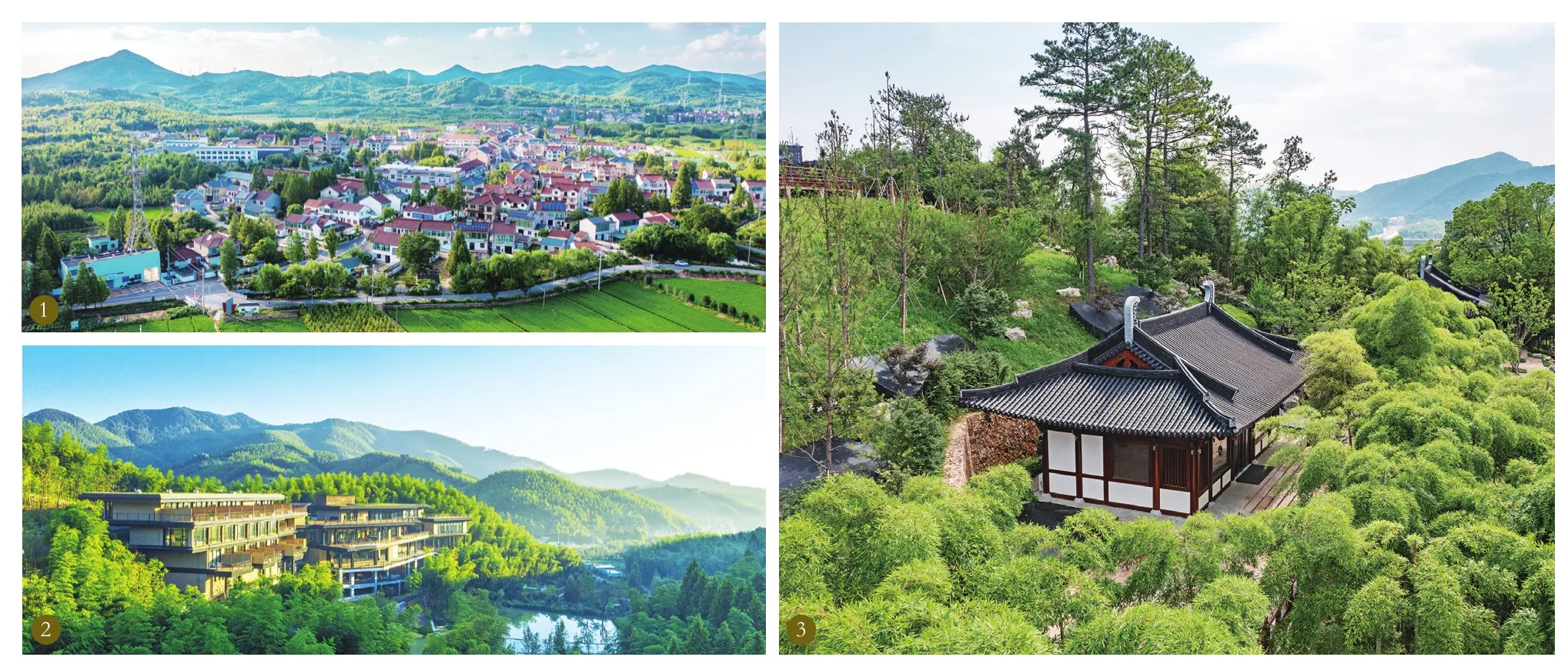古越宗庙稽留地 百越后世以水兴
文 /俞 樾

妙喜港上游霞幕山水库。The Xiamushan Reservoir in the upper reaches of the Miaoxi Port.
湖州妙西,以山为喜,以水维系,妙西的山水自古就饱蕴了文人对于山水的审美。尤其是妙喜港,不但具有通达的功能性,更加具备了美学的观赏性。在这山水蕴就的文明背后,妙喜港同样拥有着沉淀千年的历史。
稽留山里的秘密:太康失国到少康中兴的岁月
妙喜港,破妙西群山而出,迤逦向北,多少次沿着山脉曲折蜿蜒,最终能够连通到太湖平原水系,并与中原相通。可以说,妙西处在整个中国中心平原最南缘的边界地带,同时妙西所在的这片山区,是从太平洋,尤其是上海方向过来看到的第一片连续的山区,所以是山、海两种文明都想占领的守望堡。也正因为这样的地理位置,中原文明与丘陵文明会在这里碰撞,大陆文明与沿海文明会在这里争夺。妙西,既是“原之沿”,也是“山之口”,更是“海之滨”,这也因此造就了妙西多元文化相碰撞的历史。那么这片土地上,文化的第一次碰撞是在什么时候呢?
妙西有一座名为“杼山”的山,此山闻名是因为茶。但其实这座山还有一个天大的秘密,这个秘密比“茶经时期”要早很多,是与其另一个名字有关—“稽留山”。除了稽留山,妙喜港沿岸还有茅山、夏驾山、避它城、夏王村等一系列历史痕迹,这些遗痕都指向一个时代—夏朝初期姒杼的时代(杼山的由来),也更指向了夏朝初期一个重大的历史事件—於越国建立(姒杼的哥哥姒无余建立)。就让我们顺着妙喜港的时间流,溯源而上吧。
夏朝是大禹的儿子姒启建立的,可谁能想到,到大禹的孙子姒太康时,夏朝就差不多被覆灭了。让太康失国的人叫后羿,这是历史上“有窮氏族”第二位叫“后羿”的领导人。在姒启死后,五个儿子互相争夺权力。东夷中最强大的“有窮氏族”因为掌握弓箭技术,趁乱对夏王姒太康发动了攻击,结果攻破了夏朝首都斟鄩,姒太康被流放,史称“太康失国”。
后羿立太康的弟弟姒仲康为傀儡国君。仲康不服,暗自发力,结果还是被后羿击败,在位七年后郁郁而终。并且,夏朝的第二和第三任君主都被东夷氏族玩弄于股掌。

1.湖州妙西镇后沈埠村风光。 2.湖州妙西镇慧心谷绿奢度假村。 3.湖州妙西镇杼山文化公园。1.Sceneries of Houshenbu village, Miaoxi township, Huzhou city. 2. The Huixin Retreats at Miaoxi township, Huzhou city.3. The Zhushan Cultural Park at Miaoxi township, Huzhou city.
这时候,局势看似有了反转。后羿的养子寒浞杀了后羿夺得东夷最高权力。但寒浞的野心更大,开始率领东夷各族对仲康的儿子相展开攻势。相在位第一年与淮夷战,第二年与风夷和黄夷战,最终相被寒浞杀害,而且对于帮助过相反抗东夷九族的人都进行了剿灭,那是夏朝最昏暗的时期。
直到一个人出现,就是姒杼和姒无余的父亲—少康。少康是相的遗腹子,他的一生就是逆袭的过程。父亲相被寒浞残忍杀害后,少康躲在外公有仍氏族群里,领牛羊放牧,做了牧正,后来又逃往有虞氏躲起来,担任庖正—厨师长。渐渐地,他把原来帮助过父亲相的那些氏族残部余烬都收编入伍,还派出了中国历史上第一个女间谍—女艾,打入寒浞儿子浇的势力内部,窃取信息。最终经过几场惨烈的大战,少康复国了,夏朝政权再一次复燃。少康复国后,九夷之中只有一个氏族前来道贺,所以东夷九族始终是夏朝的心头大患,于是少康在晚年尽全力做了一次关键的决断,那就是派出庶子姒无余,在“大越之地”建立於越国,表面上是“奉祀大禹陵”,实际上对东夷成犄角之势牵制(东夷主要在山东、江苏沿海地区)。这是一枚重要棋子,伺机待发。
少康极其聪明,他以“给大禹守陵”的名头建立古越国,因为大禹曾经娶了东夷氏族的领袖之一涂山氏的涂娇,所以东夷氏族对大禹这位天下共主还是有所忌惮的。那么这个建立古越国的“大越之地”在哪里?跟妙西又有什么关系呢?
古越国建在湖州,古会稽在妙西
《吴越春秋》记载:“勾践语范蠡曰:‘先君无馀(即姒无余),国在南山之阳,社稷宗庙在湖之南。’”
勾践回忆中所说的“国”是指越国的都城,所在地就是《史记 · 太史公自序第七十》所说的:少康之子,文身断发,鼋鳝与处,既守“封禺”,奉禹之祀。《说文解字 · 山部》云:“封、禺之山在吴楚之间,汪芒氏之国。”也就是现在的德清武康下渚湖这一带,是防风古国(防风也叫汪芒)国都所在。
而越国的社稷宗庙—大禹陵,也就是“会稽”,此时还不在绍兴,而是在湖州。“社稷宗庙在湖之南”,这里的湖就专指太湖,当时“江河湖海”都是专指,江专指长江,河专指黄河。至于鄱阳湖、洞庭湖当时与湖北绝大多数地域连为一体,统称云梦泽,分云泽和梦泽,后来云梦泽萎缩成了云梦泽和彭蠡泽,最后再度萎缩成了鄱阳、洞庭等各个湖泊,而在当时云梦泽专有名字是“泽”。
“湖之南”的古会稽山,东北西缘是平原或谷地,南缘是以北苕溪为界的整个山区就是最早的会稽山,会稽山与别的山不同之处在于它是“大禹陵所在”。
这在《水经注》中的记载就更加明确了:“会稽之山……北邻大湖。”大湖就是太湖古时的另一个名字,最早会稽山都是以太湖为参照,而不是以钱塘江,因为绍兴在钱塘江南,钱塘江古称浙江,是跟太湖同一级别的地理参照物。
大禹最早的陵墓在妙西。这句话乍一听石破天惊,但我们先来看看关于大禹最后的记载:“禹始也,忧民救水,到大越,上茅山,大会计,爵有德、封有功,更名茅山曰会稽。”(《越绝书 · 外传记地》)
首先我们先要明确什么是“大越之地”。大越就是居住在“大湖地区”的越人之地,《越绝书》中又写明了“大越故界,浙江至就李,南姑末、写干。”也就是以浙江(钱塘江)为界,向东至嘉兴南部,向西南到达龙游县以北,甚至是江西地区。我们大致可以描绘出古越国—大越之地的国界。其实就是现在所说的浙北,包括湖州、嘉兴、杭州北部地区。
大禹当时就是在这片土地上的茅山大会诸侯,然后更名茅山为会稽山,最后也是葬于此山中。同时大禹子孙在建立最早的古越国时,建都在这座山的南边。上文讲到的妙西的这座杼山,另外有个名字就叫做“稽留山”。关于杼山,陆羽旧记云:“山高三百尺,周回一千二百步,昔夏后杼巡猎之所。今山下有夏王村,西北有夏驾山。”茅山的不远处正是夏驾山,驾在古时特指帝王之车。而在杼山下的很大一片地,被称作“棺材冲”,其形制跟史书中所说“夏禹之丧,桐棺三寸,蘧蒢以敛,余壤为坋”一致。而夏王村附近至今流传着大禹治水的丰富传说。
而在妙喜港东边道场山区的另一侧,大禹爷爷颛顼的墓地静静地安置在倪横山上,晋朝时墓室因为山体滑坡而出现。大禹的第四代传人夏王杼又在杼山上建立了避它城。南宋叶梦得在《避暑录话》中说:“今州之西南有杼山,亦隶乌程,其旁有夏驾山王村,夏杼巡狩所至。杼,夏之七王也。禹葬会稽,则杼之至此,固无足怪。”这一切都指向了太湖之南、妙喜港畔的这片山泽不一般。

湖州妙西镇沈家本历史文化园。The Shenjiaben Historical and Cultural Part at Miaoxi township, Huzhou city.
南宋史学家罗泌当年为了写《路史》(中国最详尽的远古史学书籍),来到妙西,在杼山费尽心力挖掘,最终在此处得到了“夏后之铭”,《路史》原文为“自余季甫志学遾通三经,且待且业,未尝终日三商不属意,于是史也。访博士、适异书、讯旅人、求金石之遗豫…于黄龙得女娲之碣,于荼水得炎帝之陵……于杼山得夏后之铭”。“夏后”即“夏王”,是夏启自创的一个帝位称谓,所以在杼山得到的这个“夏后之铭”,在罗泌眼中与“女娲之碣”“炎帝之陵”是处在相同等级的惊世文物,虽然铭文现在已经无踪,但是可以看出杼山在大禹传人眼中的地位极其崇高。
会稽最后安置在绍兴
在古越国那几年,国都在德清武康,社稷宗庙(会稽)在吴兴妙西,后世的贵族墓葬都在安吉龙山,尤其是安吉龙山这几年挖掘出了允常之前的古越墓葬群268座古墓。
所以湖州拥有古越国三大圣地,三位一体地构成了古越国的核心区。这一片山区在秦朝时期还有一个名字“馀望山”,也就是后世的“余杭山”。那么为什么后来的会稽在绍兴?
因为吴越争霸。吴国南进,越国南退,“会稽”不断南迁,所迁旧地都被称为“稽留山”,湖州妙西杼山是稽留山,杭州仁和有稽留山,甚至灵隐寺所在的山也曾被称作“稽留山”。最终在越王勾践时,古越国的地盘被吴国夺去,越王勾践在被囚禁了几年后,被放到了钱塘江以南的绍兴,当时那一幕这样被记载:
“今欲定国立城...孤不能承前君之制,修德自守,亡众栖于会稽之山……幸来归国,追以百里之封,将遵前君之意,复于会稽之上,而宜释吴之地。”(《吴越春秋 ·勾践归国外传》)
勾践其实说得很清楚:如今我被吴国放出来,要定新的国都,但是很惭愧,“前君之制”我已经不能继承了,做不到修德自守,也做不到让亡故的人能够在(老)会稽山上安葬。所幸我回来了,拿到了百里的封地,我要把“前君之意”尊崇下来,再置一片“新会稽”,适合用来释怀如今被吴国占领的故土。
从此,越国从钱塘江以北的大越之地,迁到了钱塘江以南,会稽也来到了绍兴会稽山,可以说,湖州杭州的稽留山和绍兴的会稽山都是一脉相承。古越这一脉,此后不断随着中原势力的南进而沿海南退,创造了瓯越、闽越、俚越、雒越等一系列的“越国”,世称“百越”。
Time-Honored Kuaiji and the Ancient State of Yue
By Yu Yue
Miaoxi is a pleasant place embraced by mountains and connected by waters. Its natural landscape has been fully reflective of literati’s aesthetics since ancient times, especially Miaoxi Port,a hub of convenient transport and aesthetic attractions with a history of over a thousand years.
Emerging from local mountains, Miaoxi Port winds northward along the mountains before it is finally able to connect to the water system of Taihu Lake plain and to the Central Plains. It can be said that Miaoxi is in the border zone of the southernmost edge of the whole Central Plains, while this mountainous area where Miaoxi is located is the first continuous mountainous area seen from the Pacific Ocean, specifically from Shanghai. Therefore, it is a watchtower that witnesses the development of both mountain and sea civilizations. Because of this geographical location, Miaoxi has undergone multiple cultural collisions historically. So when was the first collision?
Miaoxi has a Zhushan Mountain famously known for its rich tea culture. But in fact there is a big secret in this mountain, which has something to do with its other name — “Jiliu Mountain”. It points to a significant historical event in the early Xia dynasty (ca.2070-1600 BC).
Establish by Qi, son of Dayu (Yu the Great), Xia dynasty was unexpectedly brought down during the period of Dayu’s grandson,Taikang. After the death of Qi, his five sons vied with each other for power. The chaos was thus taken advantage of by Houyi and his clan from the Dongyi (Eastern barbarians), who with their mastery of bow and arrow launched an attack on Taikang’s reign.As a result, the capital was captured and Taikang was forced into exile.
Houyi made a puppet ruler out of Zhongkang, Taikang’s younger brother, while the latter could not take it and made secret moves to reclaim power, only to be defeated by the former. The second and third kings of the Xia dynasty were also manipulated by the Dongyi.
When Houyi was killed by his foster son who then seized power, it looked like the situation was about to be turned.However, the new king was even wilder with ambition, leading all his clans to wipe out the people reigned by Zhongkang’s son. That was the darkest period of the Xia dynasty.
It was not until Shaokang appeared that things started to look up. After several ferocious battles, Shaokang finally reclaimed the Xia dynasty from the grip of the Dongyi, who nevertheless were still a thorn in Shaokang’s eyes. Therefore, Shaokang made a wise decision in his later years: he sent his son Wuyu to the “land of the Great Yue” to establish the State of Yue (2031-222 BC). On the surface it was dedicated to worshipping the Dayu Mausoleum, but in fact it was a strategic move to keep in check the Dongyi clans(mainly in nowadays Shandong and Jiangsu provinces). But where is the “land of the Great Yue”, and the ancient State of Yue? And what does it have to do with Miaoxi?
According to thethe ancestral temple of the State of Yue or the Dayu Mausoleum,(known as “Kuaiji”), is “at the southern side of Taihu Lake” in Huzhou, Zhejiang. The location of the ancient Kuaiji Mountain at the south of Taihu Lake is roughly drawn in the following map: to the northeast and west edges are plains or valleys, and to the south edge is the whole mountainous area bounded by the North Tiaoxi River, which was the earliest Kuaiji Mountain.
It is said that the earliest Dayu Mausoleum was in Miaoxi.This may sound shocking, but let’s first look at some historical records. First, we need to know what exactly is “the land of the Great Yue” — it refers to the land of the Yue people, who lived in the “Great Lake Region”. Then we can approximately depict the boundaries of the ancient Yue state, or “the land of the Great Yue”.It is in nowadays northern Zhejiang, including the north part of Huzhou, Jiaxing and Hangzhou.
It was on this land that Dayu met with the vassals at the Maoshan Mountain, and he then renamed the Maoshan mountain as the Kuaiji Mountain — it was also where he was buried later.And at the same time, when Dayu’s descendants established the earliest Yue state, they built the capital at the south of this Kuaiji Mountain.
The Zhushan Mountain in Miaoxi, which we mentioned earlier, is also known as “Jiliu Mountain”,which means “the former Kuaiji Mountain”. On the other side of the Daochang Mountain area at the east of Miaoxi Port, the tomb of Zhuanxu, Dayu’s grandfather,sits quietly on the Niheng Mountain. Zhu the King,fourth generation of Dayu’s successor, built another city called Bita city on the Zhushan Mountain. All this points to the fact that this mountain is nothing ordinary.
During the period of the ancient Yue state, the capital was in Wukang, Deqing, the ancestral temple (Kuaiji) was in Miaoxi, Wuxing, and the nobles of later generations were all buried in Longshan Mountain of Anji, where 268 ancient tombs have been excavated recently.
Therefore, Huzhou has three sacred places of the ancient Yue state, and this trinity constitutes the core area of the Yue state. This mountainous area has another name “Yuwang Mountain” during the Qin dynasty (221-207 BC), which is also known as “Yuhang Mountain” in later times. But why did Kuaiji end up in Shaoxing?
That was because of states Wu and Yue, which were then vying for hegemony. The State of Wu (ca.12th century-473 BC) advanced southward while Yue retreated southward, resulting in the constant southward movement of “Kuaiji”. The old places from which Kuaiji emigrated were all named “Jiliu” mountains,from Miaoxi’s Zhushan Mountain in Huzhou, to two mountains in Hangzhou — one is in Renhe, another is the mountain where Lingyin temple is located. When Yue was finally taken by Wu, Goujian (520-464 BC),King of Yue, was exiled to Shaoxing after several years of imprisonment.
Since then, the State of Yue has been relocated from the north to the south of the Qiantang River, and Kuaiji also came to be the Kuaiji Mountain in Shaoxing.Therefore, it is safe to say that the Jiliu mountains in Huzhou, Hangzhou and the Kuaiji Mountain in Shaoxing have the same origin. The ancient Yue state,since then, had withdrawn southward along the east coast, breeding various ethnic groups such as Ou Yue,Min Yue, Li Yue, Luo Yue, etc., collectively known as the Baiyue (Hundred Yue).

“妙山十景”之稻花鱼田。Rice flowers and fish fields, one of “Ten Sceneries of Miaoshan Mountain”.

